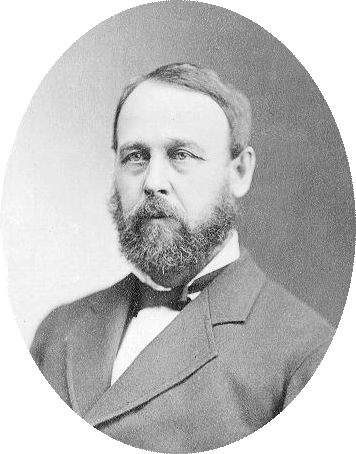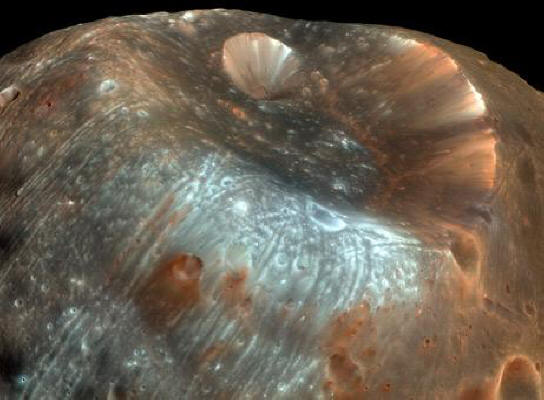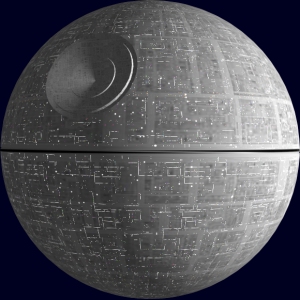Phobos: Mars' Doomed Moon
By Garvin Peters & Stephen Labarge

Phobos orbiting it's planet, Mars
History of Phobos:
On August 18th, 1877, astronomer Asaph Hall Senior (who was working at the United States Naval Obvservatory) discovered the first of Mars' moon, Phobos (he would go on to discover the other, Deimos, at a later time). The Name "Phobos" means "Fear", which was suggested by Henry Madan, who got the idea from Book XV of the Illiad, where Ares, the god of war, summoned Phobos and Deimos.

Asaph Hall Senior
About Phobos
Although you may expect a moon to be similar to our (very spherical in nature), Phobos is far from it. With dimensions of 27 x 22 x 18 kilometers, it is far from round. Because of this irregular shape, the the gravity is greatly affected. On it's own, the gravity on the surface of Phobos varies by as much as 210%, and when combined with Mars' tidal forces, gravity can vary by as much as 450%! But, it is important to remember tht even though the gravity varies greatly, it is still exremely low overall.

3D Representation of Phobos
The surface of Phobos is covered by a thick layer of fine-grained regolith (atleast 100 meters thick), which is thought to have been created by impacts of other bodies, but it is unknown how the regolith stays on this moon with such low gravity. Phobos is also heavily cratered, with the most noticeable crater being the Stickney Crater. Named after Asaph's wife Angeline Stickney Hall, this crater is 9 km in diamter and takes up a large portion of the Phobos' surface. The impact is said to have almost shattered Phobos completely.

Exaggerated Photo of the Stickney Crater
As a whole, phobos cannot be a solid rock because it's density is much too low. In addition, there is a large amount of porosity (void or empty spaces spaces)in the in the objects in and on phobos, which suggests that Phobos may contain a reservoir of ice. Although the surface of Phobos lacks oxygen, ice below the regolith cannot be ruled out.
Phobos' Orbit
Phobos orbits Mars below the synchronous orbit radius, meaning that it moves extremely fast to stay in its orbit and, as a result, moves around Mars faster that Mars rotates itself. Therefore, Phobos spends at most about 4 hours and 15 minuts in the sky at a given point (from moon rise to moon set), and makes its trip two times a day ( about every 11 hours).
Because Phobos is so close to Mars, the tidal forces have an amazing amount of effect on the moon. These tidal forces are slowly pulling Phobos closer and closer to Mars at a rate of about 20 meters per century. This means that 2 things will result. One is that in approximately 11 million years it will collide with Mars and be destroyed. The other option is that once Phobos crosses the Roche Limit (the point at which the second celestial body's tidal forces exceed Phobos' gravity), it will be ripped apart and form a temporary belt around Mars.
The Roche limit





Modern Day References
If you've ever watched Star Wars, The Death Star is modeled after Phobos! See the resemblance?


Possible Experiments
We plan to send a collection of living organisms on a three-year trip to the Martian moon Phobos and back to Earth. The will help us better understand the nature of life, its robustness, and its ability or not to move between planets. The journey will be a test of one aspect of the transpermia hypothesis -- the possibility that life can travel from planet to planet inside rocks blasted off one planetary surface by impact, to land on another planetary surface. The experiment will test the ability of life to survive the interplanetary voyage by flying organisms for several years through interplanetary space in a simulated meteoroid. The spacecraft will land on Phobos, collect dirt and rocks from its surface, and then head back home. As it swoops by Earth, the spacecraft will release a capsule containing all the samples gathered on Phobos, to land on Earth. Attached to the capsule for the entire 34 months of the journey will be a cylinder containing a collection of microbes. In its flight the cylinder will simulated space rock, subject to the same extreme conditions as a Martian meteoroid traveling to Earth.
Equipment: Orbiter and Rover
The rover can be outfitted with a mass spectrometer instrument that can provide a precise and definitive analysis of the composition of the Phobos atmosphere. The X-ray fluorescence spectrometers can measure elemental composition of the Phobos soil. As the rovers descend toward the surface they can also measure composition and physical properties of the Phobos upper atmosphere. The rover will continuously monitor weather at the landing sites. The orbiter cameras can observe new terrain and provide clearer detail on known features, including some color and stereo observations. The infrared thermal mappers and the atmospheric water detectors on the orbiters canacquire data almost daily, observing the planet at low and high resolution. Analysis of radio signals from the rovers and the orbiters signal strength of the lander-to-orbiter relay link provides a variety of valuable information.

Works Cited:
http://en.wikipedia.org/wiki/Phobos_(moon)
http://www.nineplanets.org/phobos.html
http://www.solarviews.com/eng/phobos.htm
Video: http://www.youtube.com/watch?v=-l3x4QDWxmc&feature=related
Images
Phobos above Mars: http://www.arcadiastreet.com/cgvistas/images/mars_and_phobos_600.jpg
Asaph Hall: http://upload.wikimedia.org/wikipedia/commons/2/21/Asaph_Hall_Sr.png
Stickney Crater: http://blog.wired.com/geekdad/images/2008/04/10/psp_007769_9010_irb_stickney800.jpg
Roche Limit: http://en.wikipedia.org/wiki/Roche_Limit
Death Star: http://www.eyeonstarwars.com/trilogy/vehicle/images/death_star.jpg
Phobos: http://images.spaceref.com/news/2007/PHOBOS2.jpg
NASA's Mars Reconnaissance Orbiter: http://www.martinfrost.ws/htmlfiles/mars_orbiter1.jpg
Comments (2)
Lexus said
at 1:44 pm on Jan 12, 2009
Your page is very good. It is very easy to read, which makes it easy to learn. The experiments were good, but they could be better. Organizing the experiment into easy sections would be nice and also more experiments that are both original and interesting.
kevin kearney said
at 6:51 pm on Jan 6, 2009
I thought your project was good. You used realistic experiments which i think is good and all the information is in your webpage. Stephen was able to present the information very well by himself without garvin.
You don't have permission to comment on this page.